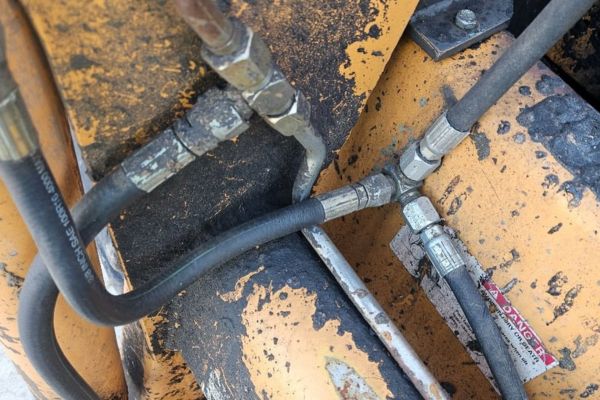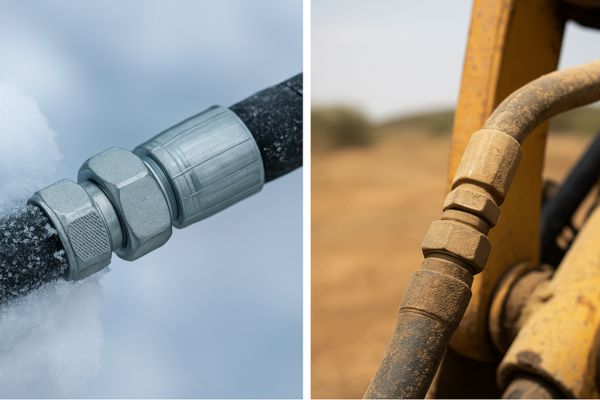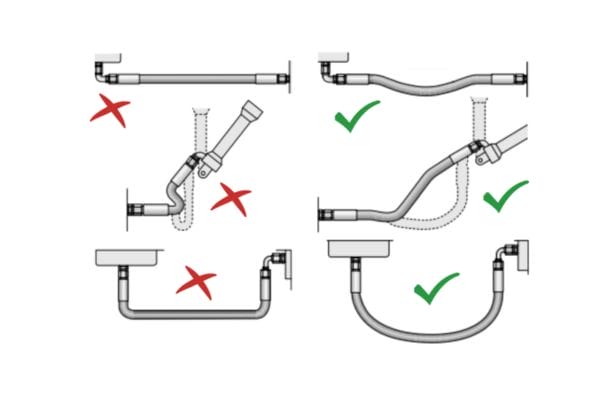Hydraulic hoses inevitably age from heat, oxygen, stress, and ozone, leading to cracks and failure. This expert guide explains the science behind hose degradation and provides practical strategies for inspection, prevention, and extending component life.
What Is Hydraulic Hose Aging?
Hydraulic hose aging is the gradual and irreversible degradation of rubber materials over time.
It’s not caused by mechanical wear but by a chemical transformation that changes the hose’s structure, turning flexible, durable rubber into material that is stiff, brittle, or sticky.
As a result, the hose loses its ability to hold pressure, flex safely, or resist environmental stress — setting the stage for cracks, leaks, and sudden failure.

The Telltale Signs: Cracking and Brittleness
The most visible symptom of hose aging is surface cracking, often referred to as weather checking or ozone cracking.
These tiny fissures usually appear on:
- The outer cover, especially near bends or clamps
- Areas exposed to sunlight, ozone, or heat
- Sections under constant vibration or flexing
As the process continues, the hose becomes rigid and less elastic, making it difficult to install or move. Under working pressure, a brittle hose is highly likely to split or burst.
| Symptom | Likely Cause | Consequence |
| Fine surface cracks | Ozone or UV exposure | Loss of flexibility and sealing integrity |
| Gray or chalky appearance | Oxidation and surface hardening | Reduced elasticity |
| Stiff or brittle texture | Cross-linking of rubber molecules | Cracking under pressure |
| Sticky or soft feel | Chain breakdown in rubber (chain scission) | Weakening and delamination |
Tip: If the cover cracks when bent by hand, the hose is beyond safe use — replace it immediately.
The Two Paths of Rubber Aging
Rubber compounds don’t all age the same way. The direction of degradation depends on material and environmental exposure.
| Aging Type | Common in | Chemical Change | Result |
| Hardening (Cross-Linking) | Nitrile (NBR), EPDM | Rubber molecules form extra bonds | Hose becomes hard, brittle, and inflexible |
| Softening (Chain Scission) | Natural Rubber (NR), SBR | Molecular chains break apart | Hose becomes sticky, weak, and prone to delamination |
Both processes weaken the material’s tensile strength and elastic memory, reducing its ability to recover from flexing or pressure cycles.
The Inevitable Loss of Performance
No matter how it occurs, aging leads to a measurable decline in hose performance:
- Reduced pressure capacity due to internal microcracks
- Decreased flexibility, increasing stress on fittings
- Higher risk of leaks or bursts under normal operation
- Shorter service life, even in mild conditions
Aged hoses are unreliable hoses — they compromise system integrity and safety. Even if a hose isn’t visibly leaking, internal deterioration can make it fail without warning.
Best Practices to Slow Aging:
- Store hoses away from direct sunlight and ozone sources (like electric motors).
- Maintain fluid cleanliness and avoid oil contamination.
- Keep system temperatures below 80°C (176°F) whenever possible.
- Follow manufacturer replacement intervals, even if hoses “look fine.”
The Primary Culprit: Thermo-Oxidative Aging
The most prevalent form of aging is a two-pronged attack from heat and oxygen. Heat acts as a catalyst, dramatically accelerating the rate at which oxygen attacks the rubber’s molecular structure, leading to rapid degradation from the inside out.
Heat: The Accelerator
For every 10°C (18°F) increase in temperature above a hose’s rated limit, its service life can be cut in half. Heat provides the energy needed for destructive chemical reactions to occur, making temperature control the single most important factor in preventing premature aging.
Oxygen: The Attacker
Oxygen is highly reactive and attacks the chemical bonds within the rubber’s polymer chains. This oxidative process is what ultimately breaks down the material, causing it to lose its elasticity and strength. It’s a slow, relentless process that heat makes exponentially faster.
The Achilles’ Heel: Unsaturation
The source of this vulnerability lies in the “double bonds” within the molecular structure of many common rubbers. These sites are chemically reactive and are the primary targets for attack by oxygen and ozone. This is why some specialized elastomers are more resistant than others.
The Silent Menaces: Ozone and UV Radiation
Beyond heat and oxygen, two invisible environmental factors are constantly working to destroy hydraulic hoses: ozone in the air and ultraviolet (UV) radiation from sunlight. These elements specifically target the hose cover, destroying its protective capabilities.
Ozone Cracking Explained
Ozone, a gas present in the atmosphere (and generated by electric motors), aggressively attacks the double bonds in rubber. This attack causes a specific type of failure: a series of cracks that always form perpendicular to any stress on the hose, such as a bend.

The Destructive Power of Sunlight
UV radiation from direct sunlight acts much like heat, providing the energy to initiate and accelerate the breakdown of rubber’s polymer chains. A hose left exposed to the sun will age much faster than one that is shielded, becoming faded, brittle, and cracked.
Fighting Back with Waxes and Antiozonants
Manufacturers combat this by adding protective agents. Antiozonant chemicals are blended into the rubber to scavenge ozone molecules. Additionally, waxes are used which “bloom” to the surface, creating a thin, sacrificial physical barrier that protects the hose from both ozone and UV.
| Aging Type | Primary Cause | Visible Signs | Common Location |
| Thermo-Oxidation | High Temperature & Oxygen | Hose becomes either hard and brittle or soft and sticky; cover may show generalized cracking. | Near engine manifolds, exhaust, pumps, or in enclosed, hot engine bays. |
| Ozone Cracking | Atmospheric Ozone Gas | A network of small, deep cracks that are always perpendicular to the direction of stress (bends). | Any exposed hose, especially those held in a fixed, bent position. Most visible on the outside of a bend. |
| UV Degradation | Direct Sunlight Exposure | The hose cover becomes faded (often turning gray), chalky, and develops a web of fine, shallow cracks. | Any hose on the exterior of a machine that is frequently stored or operated outdoors. |
The Strain of Stress: Residual and External Forces
Even the best hydraulic hoses age faster when subjected to mechanical stress.
Residual stress from manufacturing and external stress from poor installation both act as silent accelerators of hose degradation.
Once the rubber molecules are weakened by time or heat, stress provides the final push — tearing them apart and triggering premature failure.
Residual Stress from Manufacturing
Residual stress refers to internal tension “locked” into the hose during production — typically from uneven cooling, stretching, or extrusion pressure.
While more common in molded plastics, it can also appear in hoses produced under inconsistent processing conditions.
How Quality Manufacturing Prevents It:
- Uniform curing temperature across the hose length
- Controlled wire braid tension and winding speed
- Accurate mandrel alignment to prevent uneven wall thickness
- Automated inspection for concentricity and wall variation
| Manufacturing Factor | Effect on Stress | Result |
| Uneven curing | Trapped residual tension | Early cracking or deformation |
| Loose wire winding | Uneven load on reinforcement | Reduced burst pressure |
| Poor dimensional control | Wall thickness variation | Premature fatigue |
Bottom line: Reputable manufacturers design hoses to minimize internal stress, ensuring a more uniform, stable, and durable product.

The Danger of Improper Routing
External stress is far more common — and entirely preventable.
Improper hose routing, especially bends tighter than the specified minimum bend radius, puts enormous tension on the hose’s outer curve
That outer curve becomes a stress concentration zone, where microscopic cracks begin to form and spread under pressure or vibration.
Best Practices for Hose Routing:
- Always follow the minimum bend radius listed in the manufacturer’s catalog.
- Avoid sharp bends near fittings — allow a straight section equal to at least 1.5× the hose O.D.
- Use clamps or guides to maintain natural curvature and prevent sagging.
- Never route hoses in a way that causes them to rub against each other or moving parts.
| Routing Error | Consequence |
| Bend radius too tight | Outer cover cracking, reinforcement fatigue |
| Hose stretched under pressure | Separation at fittings, reduced flexibility |
| Contact with sharp edges | Abrasion and localized heat buildup |
A hose routed correctly will “relax” naturally; one forced into a tight arc is a failure waiting to happen.
Stress Concentration at Fittings
The connection points are the most vulnerable areas in any hose assembly.
Twisting a hose during installation or leaving it too short to move under system pressure concentrates stress right where the reinforcement terminates — at the crimp.
This results in:
- Cracking near the ferrule or fitting collar
- Premature cover separation or bubbling
- Loosened fittings due to repeated torsion cycles
Installation Guidelines:
- Never twist the hose; always rotate fittings to align with system ports.
- Leave enough slack to allow for pressure expansion and vibration.
- Use swivel fittings or clamps when movement is unavoidable.
Proper installation isn’t just about aesthetics — it’s about controlling mechanical stress that would otherwise magnify aging effects.
The Chemical Shield: How Manufacturers Combat Aging
While aging is inevitable, it can be significantly delayed. Hose manufacturers employ sophisticated chemical strategies, blending specific protective compounds into the rubber to act as a defense force against the primary drivers of degradation.
Enter the Antioxidants
The most effective measure is adding special chemicals called antioxidants and antiozonants. During the aging process, highly destructive molecules called “free radicals” are formed. Antioxidants work by sacrificing themselves, capturing these free radicals before they can damage the rubber’s polymer chains.
The Right Defender for the Job
There are thousands of anti-aging additives available. Amine-based types are highly effective but can stain, while phenolic types are non-staining but can be less potent. Manufacturers select a specific “package” of these additives tailored to the rubber type and intended application of the hose.
The Importance of Compounding
These additives are typically added in very small amounts, often just 1-2% of the rubber’s weight. Achieving a perfect, homogenous blend is critical to the hose’s performance. This complex art and science of “compounding” is what separates a premium, long-lasting hose from a low-cost alternative.
| Additive Type | Primary Function | Mechanism | Common Chemical Class |
| Antioxidants | Prevents degradation from heat and oxygen (thermo-oxidation). | Intercepts and neutralizes free radicals created during the oxidation process, breaking the chain reaction of degradation. | Hindered Phenols, Amines |
| Antiozonants | Specifically protects against cracking from atmospheric ozone. | Either scavenge ozone molecules at the surface or form a protective chemical barrier that resists ozone attack. | Paraphenylene-diamines (PPDs) |
| Protective Waxes | Creates a physical surface barrier. | Migrates (blooms) to the hose surface over time, forming a thin, inert wax layer that shields the rubber from ozone and UV. | Blends of microcrystalline wax |
| UV Stabilizers | Protects against degradation from sunlight. | Absorbs or scatters harmful UV radiation before it can penetrate the rubber and break down the polymer chains. | Hindered Amine Light Stabilizers (HALS) |
Your Role in the Fight: Practical Prevention Strategies
As an operator or maintenance manager, you play a vital role. By controlling the hose’s environment and following best practices for storage and installation, you can maximize the effectiveness of the manufacturer’s built-in protections and dramatically extend service life.
Mind the Temperature
Whenever possible, route hoses away from high-heat sources like exhausts. Use heat shields or fire sleeve if proximity is unavoidable. Ensure the machine’s cooling system is functioning properly to prevent systemic overheating of the hydraulic fluid.

Proper Storage is Crucial
Store new hoses in a cool, dark, dry place. Keep them away from direct sunlight and areas with potential ozone sources, such as electric motors or arc welders. Store them coiled with a large diameter, never hanging them from a single point, to avoid creating stress points.
Cleanliness and Inspection
Regularly clean your hoses. Removing grease and dirt not only allows for better heat dissipation but also makes it easier to spot the early signs of aging, such as cracking or discoloration. A clean hose is a hose you can properly inspect.
FAQ
Is an older, unused hose still good to use?
It depends on the storage conditions. A hose has a finite shelf life (typically 5-7 years) even in ideal storage. If it was stored in a hot, sunlit area, it could be significantly aged and unsafe to use, even if it looks new. Always inspect it for hardness or cracking first.
Can I use a “rubber protectant” spray on my hoses?
It is generally not recommended. Many consumer-grade protectants contain silicones or solvents that can be harmful to the specially compounded hose cover. Sticking to a policy of keeping hoses clean is the best physical maintenance.
Why did my new hose crack almost immediately?
This is almost always due to ozone attack on a stressed hose. Either the hose was installed with too tight of a bend, or it was twisted during installation. This creates high stress, providing a perfect opportunity for ozone to create deep cracks very quickly.
Does the date on the hose layline indicate an expiration date?
No, the date printed on the hose is the date of manufacture (DOM). There is no official “expiration date.” However, many industries have their own standards for maximum service life, and the DOM is used to track the hose’s age.
Are all black rubber hoses the same?
Absolutely not. The type of synthetic rubber (Nitrile, Neoprene, EPDM, etc.) and the specific package of anti-aging additives used by the manufacturer make a massive difference. Two black hoses can have drastically different temperature ratings and resistance to aging.
My hose became very soft and gummy. What caused this?
This is likely a case of material incompatibility or severe overheating. Certain fluids can attack and break down the inner tube, or extreme heat can cause the rubber polymer to revert to a softer, weaker state. The hose is compromised and must be replaced.





